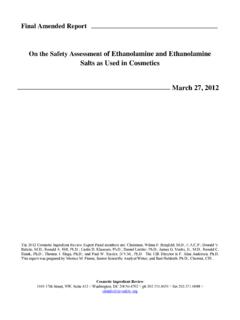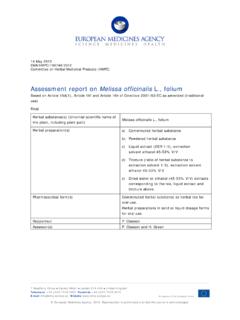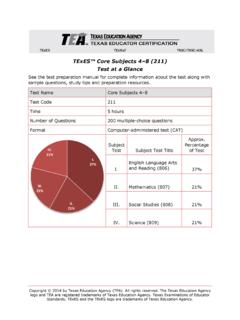Transcription of Assessment report on Chelidonium majus L., herba
1 7 Westferry Circus Canary Wharf London E14 4HB United Kingdom Telephone +44 (0)20 7418 8400 Facsimile +44 (0)20 7523 7051 E-mail Website An agency of the European Union European Medicines Agency, 2012. Reproduction is authorised provided the source is acknowledged. 13 September 2011 EMA/HMPC/369801/2009 Committee on Herbal Medicinal Products (HMPC) Assessment report on Chelidonium majus L., herba Based on Article 10a of Directive 2001/83/EC as amended (well-established use) Based on Article 16d(1), Article 16f and Article 16h of Directive 2001/83/EC as amended (traditional use) Final Herbal substance(s) (binomial scientific name of the plant, including plant part) Chelidonium majus L., herba Herbal preparation(s) Internal Use a) Chelidonii herba : comminuted b) Chelidonii tincture: 1:10, 45% ethanol (V/V) c) Chelidonii extractum fluidum: 1:1, 25% ethanol (V/V) d) Chelidonii extractum siccum (concentration not specified) e) Chelidonium majus ( ) prepared with 70% ethanol (HAB) External Use a) Eye-drops: (preparation not specified) b) Ointment: (concentration not specified) Pharmaceutical forms Herbal preparations in solid or liquid dosage form or as an herbal tea for oral use.
2 Herbal preparation in solid or liquid dosage form for external use. Rapporteur Gert Laekeman Assessor(s) Pieter-Jan Corne, Frederic Vandewalle Assessment report on Chelidonium majus L., herba EMA/HMPC/369801/2009 Page 2/40 Table of contents 1. 3 Description of the herbal substance(s), herbal preparation(s) or combinations thereof . 3 Information about products on the market in the Member States .. 7 Search and Assessment 10 2. Historical data on medicinal use .. 10 Information on period of medicinal use in the Community .. 10 Information on traditional/current indications and specified substances/preparations.
3 11 Specified strength/posology/route of administration/duration of use for relevant preparations and 11 3. Non-Clinical Data .. 11 Overview of available pharmacological data regarding the herbal substance(s), herbal preparation(s) and relevant constituents thereof .. 11 Overview of available pharmacokinetic data regarding the herbal substance(s), herbal preparation(s) and relevant constituents thereof .. 19 Overview of available toxicological data regarding the herbal substance(s)/herbal preparation(s) and constituents 21 Overall conclusions on non-clinical 24 4. Clinical Data .. 26 Clinical Pharmacology .. 26 Overview of pharmacodynamic data regarding the herbal substance(s)/preparation(s) including data on relevant constituents .. 26 Overview of pharmacokinetic data regarding the herbal substance(s)/preparation(s) including data on relevant constituents.
4 26 Clinical Efficacy .. 27 Dose response 27 Clinical studies (case studies and clinical trials).. 27 Clinical studies in special populations ( elderly and children).. 32 Overall conclusions on clinical pharmacology and efficacy .. 32 5. Clinical Safety/Pharmacovigilance .. 32 Overview of toxicological/safety data from clinical trials in 32 Patient exposure .. 33 Adverse events .. 35 Serious adverse events and deaths .. 38 Laboratory findings .. 38 Safety in special populations and situations .. 38 Overall conclusions on clinical safety .. 39 6. Overall conclusions ..39 Annex .. 40 Assessment report on Chelidonium majus L., herba EMA/HMPC/369801/2009 Page 3/40 1. Introduction Description of the herbal substance(s), herbal preparation(s) or combinations thereof Herbal substance(s) The European Pharmacopoeia (01/2008:1861) monograph provides the following definition for Chelidonii herba : dried, whole or cut aerial parts of Chelidonium majus L.
5 Collected during flowering. Content: minimum per cent of total alkaloids, expressed as chelidonine (C20H19NO5; Mr ) (dried drug). Chelidonium majus L. is known under the synonyms: English: greater celandine, devil s milk, rock poppy, tetterwort, swallow-wort Italian: celidonia, erba di porri, cinerognola, erba maistra, erba nocca German: Sch llkraut, Schellkraut, Schwalbenkraut, Goldwurz, Blutkraut, Gelbes Millkraut French: ch lidoine, Herbe d claire, Herbe de l hirondelle, Felougue, herbes de Sainte Claire, Herbe hirondalle Dutch: stinkende gouwe Spanish: celidonia Portugal: celidonia Polish: ziele glistnika, z otnik, jask cze ziele, glistnik pospolity There are over 20 different Chelidonium alkaloids identified. According to Barnes et al. (2007) and Bruneton (1999), the different groups of chemical molecules which are present in the herb of Chelidonium majus are: - Benzylisoquinoline type ( ): with at least three subgroups: Benzophenanthridines: chelerythrine, chelidonine, sanguinarine, isochelidonine Protoberberines: berberine, coptisine, dihydrocoptisine, stylopine Protopine - Acids: chelidonic, malic, citric, caffeic ( ) ferulic ( ), p-coumaric ( ), gentisic and p-hydroxybenzoic acids - Hydroxycinnamic acid derivates: (-)-2-(E)-caffeoyl-D-glyceric acid, (-)-4-(E)-caffeoyl-L-threonic acid, (-)-(2)-(E)-coffeoyl threonic acid lactone, (+)-(E)-caffeoyl-L-malic acid - Others: a saponine, carotenoids, a phytocytostatin (chelidocystatin), sparteine and flavonoids.
6 Chelidonium majus L. belongs to Papaveracecae family and is widely distributed across the world. It can be found in Europe, Asia, Northwest Africa and North America. It is a typical ruderal plant that grows on nitrogenous grounds. Historically, Chelidonium majus was already used in the Middle Ages. It was mentioned by Plinius and Dioscorides. The name Chelidon ( ) in Greek means swallow because the plant begins to flower when the swallows return. Assessment report on Chelidonium majus L., herba EMA/HMPC/369801/2009 Page 4/40 Figure 1. Alkaloids of Chelidonium majus (Barnes et al. 2007) Assessment report on Chelidonium majus L., herba EMA/HMPC/369801/2009 Page 5/40 Figure 2. Acids of Chelidonium majus (Barnes et al. 2007) Herbal preparation(s) Internal use: - Chelidonii herba comminuted: g as a tea infusion (ESCOP 2003) - Chelidonii tinctura (45% Ethanol V/V): 2-4 ml of a 1:5 preparation daily or 2-4 ml of a 1:10 preparation three times daily (Barnes et al.)
7 2007) Assessment report on Chelidonium majus L., herba EMA/HMPC/369801/2009 Page 6/40 - Chelidonii extractum fluidum (25% ethanol V/V): 1-2 ml of a 1:2 preparation daily or 1-2 ml of a 1:1 preparation three times daily (Barnes et al. 2007) - Chelidonii extractum siccum (concentration not specified): 100-200 mg three times daily (Van Hellemont 1985; Delfosse 1998) - Chelidonium majus ( ) (70% ethanol HAB): three times 15 drops daily (Van Hellemont 1985; Delfosse 1998) External use: - Eye-drops, one drop three times daily (Kommission C 1992; linked to anthroposophic medicine): Chelidonium , volatile grade of dilution D4 to D30 Chelidonium Rh, volatile grade of dilution D4 to D30 Chelidonium Flos (ethanol), volatile grade of dilution D4 to D30 Chelidonium Flos Rh, volatile grade of dilution D4 to D30 - Ointment, apply 1-2 times daily on rash (Kommission C 1992.
8 Linked to anthroposophic medicine) Chelidonium majus ( ) Chelidonium e radice ferm 34b, volatile grade of dilution D3 to D30 Chelidonium ex herba cum radice ferm, volatile grade of dilution D3 to D30 Combinations of herbal substance(s) and/or herbal preparation(s) including a description of vitamin(s) and/or mineral(s) as ingredients of traditional combination herbal medicinal products assessed, where applicable. A few herbal preparations in combination with Chelidonium majus are described in the Deutschen Rezeptformeln: Tinctura Cholagoga (DRF) (a combination of Chelidonium majus tincture with Silybum marianum tincture and Strychnos nux-vomica tincture) and Tinctura Cholagoga Fortis (DRF) (a combination of Chelidonium majus tincture, Silybum marianum tincture, Atropa belladonna tincture and Mint Oil) (Van Hellemont 1985; Weiss & Fintelman 1999).
9 Another common combination product is a liquid formulation that consists of nine herbs. Iberogast contains a fixed combination of hydroethanolic herbal extracts from bitter candy tuft (Iberis amara totalis), peppermint leaves (Menthae piperitae folium), chamomile flower (Matricariae flos), liquorice root (Liquiritiae radix), angelica root (Angelicae radix), caraway fruit (Carvi fructus), milk thistle fruit (Silybi mariani fructus), lemon balm leaves (Melissae folium) and greater celandine herbs (Chelidonii herba ). Each of them is reported to have multiple pharmacological properties relevant in gastrointestinal pathophysiology (Wegener and Wagner 2006). According to Wegener and Wagner (2006), it is a prokinetic that is indicated for irritable bowel syndrome and dyspepsia. The composition of 100 ml liquid is the following: Extracts from: Iberis amara (fresh whole plant) (1 ) ml, extraction solvent: ethanol 50% (V/V) Angelicae radix (1 ) ml Matricariae flos (1:2-4) ml Carvi fructus (1 ) ml Cardui mariae fructus (1 ) ml Melissae folium (1 ) ml Assessment report on Chelidonium majus L.
10 , herba EMA/HMPC/369801/2009 Page 7/40 Menthae piperitae folium (1 ) ml Chelidonii herba (1 ) ml Liquiritiae radix (1 ) ml Extraction solvent for all: ethanol 30% (V/V) Vitamin(s) Not applicable Mineral(s) Not applicable Information about products on the market in the Member States Austria Combination product containing 9 herbal preparations including Chelidonii herba 30% ethanolic extract (DER 1 ) 10 ml/100 ml. (See composition under section ) Belgium Preparation A combination product contains the tincture of Chelidonium majus 45 mg, the tincture of Thuja species 45 mg, acetic acid 80 mg, lactic acid 20 mg, salicylic acid 135 mg in 9 ml solvent. Indication: topical treatment of warts. Regulatory According to the Belgium Royal Decree of 1997, Chelidonium is included in list 3 that includes substances which can be used in medicines as well as in food supplements.














